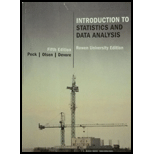
The paper “The Psychological Consequences of Money” (Science [2006]: 1154–1156) describes several experiments designed to investigate the way in which money can change behavior. In one experiment, participants completed one of two versions of a task in which they were given lists of five words and were asked to rearrange four of the words to create a sensible phrase. For one group, half of the 30 unscrambled phrases related to money, whereas the other half were phrases that were unrelated to money. For the second group (the control group), none of the 30 unscrambled phrases related to money. Participants were 44 students at Florida State University.
Participants received course credit and $2 for their participation. The following description of the experiment is from the paper:
Participants were randomly assigned to one of two conditions, in which they descrambled phrases that primed money or neutral concepts. Then participants completed some filler questionnaires, after which the experimenter told them that the experiment was finished and gave them a false debriefing. This step was done so that participants would not connect the donation opportunity to the experiment. As the experimenter exited the room, she mentioned that the lab was taking donations for the University Student Fund and that there was a box by the door if the participant wished to donate. Amount of money donated was the measure of helping. We found that participants primed with money donated significantly less money to the student fund than participants not primed with money [t(38) = 2.13, P< 0.05].
The paper also gave the following information on amount donated for the two experimental groups.
![Chapter 11.4, Problem 58E, The paper The Psychological Consequences of Money (Science [2006]: 11541156) describes several](https://content.bartleby.com/tbms-images/9781337793612/Chapter-11/images/93612-11.4-60e-question-digital_image_001.png)
- a. Explain why the random assignment of participants to experimental groups is important in this experiment.
- b. Use the given information to verify the values of the test statistic and degrees of freedom (38, given in parentheses just after the t in the quote from the paper) and the statement about the P-value. Assume that both
sample sizes are 22. - c. Do you think that use of the two-sample t test was appropriate in this situation? Hint: Are the assumptions required for the two-sample t test reasonable?
Want to see the full answer?
Check out a sample textbook solution
Chapter 11 Solutions
Introduction to Statistics and Data Analysis
- solve the question based on hw 1, 1.41arrow_forwardT1.4: Let ẞ(G) be the minimum size of a vertex cover, a(G) be the maximum size of an independent set and m(G) = |E(G)|. (i) Prove that if G is triangle free (no induced K3) then m(G) ≤ a(G)B(G). Hints - The neighborhood of a vertex in a triangle free graph must be independent; all edges have at least one end in a vertex cover. (ii) Show that all graphs of order n ≥ 3 and size m> [n2/4] contain a triangle. Hints - you may need to use either elementary calculus or the arithmetic-geometric mean inequality.arrow_forwardWe consider the one-period model studied in class as an example. Namely, we assumethat the current stock price is S0 = 10. At time T, the stock has either moved up toSt = 12 (with probability p = 0.6) or down towards St = 8 (with probability 1−p = 0.4).We consider a call option on this stock with maturity T and strike price K = 10. Theinterest rate on the money market is zero.As in class, we assume that you, as a customer, are willing to buy the call option on100 shares of stock for $120. The investor, who sold you the option, can adopt one of thefollowing strategies: Strategy 1: (seen in class) Buy 50 shares of stock and borrow $380. Strategy 2: Buy 55 shares of stock and borrow $430. Strategy 3: Buy 60 shares of stock and borrow $480. Strategy 4: Buy 40 shares of stock and borrow $280.(a) For each of strategies 2-4, describe the value of the investor’s portfolio at time 0,and at time T for each possible movement of the stock.(b) For each of strategies 2-4, does the investor have…arrow_forward
- Negate the following compound statement using De Morgans's laws.arrow_forwardNegate the following compound statement using De Morgans's laws.arrow_forwardQuestion 6: Negate the following compound statements, using De Morgan's laws. A) If Alberta was under water entirely then there should be no fossil of mammals.arrow_forward
- Negate the following compound statement using De Morgans's laws.arrow_forwardCharacterize (with proof) all connected graphs that contain no even cycles in terms oftheir blocks.arrow_forwardLet G be a connected graph that does not have P4 or C3 as an induced subgraph (i.e.,G is P4, C3 free). Prove that G is a complete bipartite grapharrow_forward
 Holt Mcdougal Larson Pre-algebra: Student Edition...AlgebraISBN:9780547587776Author:HOLT MCDOUGALPublisher:HOLT MCDOUGAL
Holt Mcdougal Larson Pre-algebra: Student Edition...AlgebraISBN:9780547587776Author:HOLT MCDOUGALPublisher:HOLT MCDOUGAL
